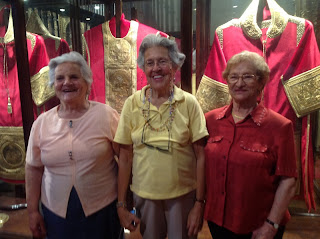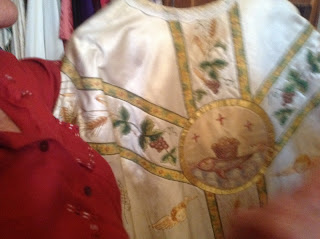 |
| Castle Ruins |
Then we drove to the church of of San Miguel dating back to the 16th century. Here we were going to see some vestments that have been kept here for special occasions that the priests may wear for processions and other occasions. We had to wait for La Duena who kept the keys with her. So we sat and took pictures while we waited.
 |
| Fran and Tim waiting for the lady with the keys |
Father Cadarso explained that the vestments were of great value so they had to be locked up.
 |
| Fatther Cadarso explaining about the vestments while Mary writes everything down and Bonnie listens. |
 |
| The lady with the keys |
 |
| Wow, these were big keys! |
Now to find the right one that will open the door!
 |
| One of these will fit the door! |
St. Michael was seen at the top of the figures in the altar piece.
 |
| San Miguel (St. Michael) |
The roses and geraniums were still fresh from the last service.

All the important vestments were behind glass cases. They were made by hand and had been kept in good shape for hundreds years. We all listened to what he had to say. The vestments were used for masses and for processions as far back as the 17th century.
Some were kept in a closet and were taken our so we could see them closer.
Embroidery work is an art form. The best in the trade did this fine work for the church because the church expected perfection. My grandmother on my mother's side was a remarkable embroidery artist and she was asked to do some embroidery work for my grandfather who had become a member of the city order in Potosi, Bolivia. That is how they met and fell in love. So embroidery work is a special art in our family.
Some vestments were also placed in drawers for safe keeping.
The ladies also shared something very special with us. They took the keys and went to a special area and opened up a box. They opened up the box to show us human bones that were kept there. These were bones of the bishop of Cuszco and a scroll written in characters similar to Hebrew like some scrolls in Jerusalem.
These bones were very special and were kept under lock and key. And we saw how carefully they locked every thing and put it back in its place.
We thanked the ladies who were eager to share everything with us and tell of their stories. But alas, time was of the essence and we had to say our good -by. Father Cadarso was thankful that he got to share these lovely vestments with us and thanked the ladies for making a special trip for us to open the treasures of the church.
Fran posed with the two ladies in front of the glass case of vestments.
 | |||
| Fran with the ladies that care for the church. |
We got back on the bus and rode by some Roman ruins that were still outcrops form the first century.
One wonders how much of our civilization will remain for our future.










No comments:
Post a Comment